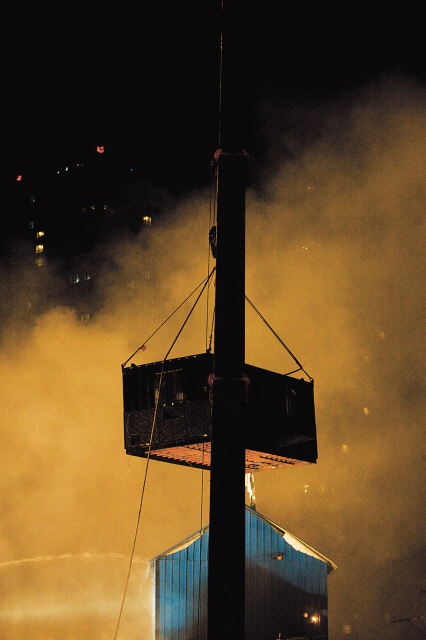Indie documentary ‘reconstructs’ 2009 Yongsan tragedy
By Claire LeePublished : July 17, 2012 - 19:48
“Two Doors” attracts 40,000 viewers just three weeks after its release
On Jan. 20, 2009, residents of a redevelopment area in Yongsan, Seoul, had been occupying the top floor of a four-story building named “Namildang” since the previous day to protest the city project.
A police SWAT team was sent in to arrest the protesters. A fire erupted during the violent pre-dawn raid, killing five protesters and one policeman. The Seoul Central District Court held the leaders of the protest responsible for the blaze and sentenced them to jail terms. The incident is now widely known as the “Yongsan tragedy.”
On Jan. 20, 2009, residents of a redevelopment area in Yongsan, Seoul, had been occupying the top floor of a four-story building named “Namildang” since the previous day to protest the city project.
A police SWAT team was sent in to arrest the protesters. A fire erupted during the violent pre-dawn raid, killing five protesters and one policeman. The Seoul Central District Court held the leaders of the protest responsible for the blaze and sentenced them to jail terms. The incident is now widely known as the “Yongsan tragedy.”

There have been a number of documentaries about what happened that day. Director Oh Doo-hee’s 2010 film “The Story of Namildang in Yongsan” followed a group of aged women who insisted on staying in Namildang for about a year after the incident, until the building was demolished in December 2010. “My Sweet Home,” director Kim Cheong-seung’s 2010 film, features three protesters who were sentenced to seven years in prison for their roof-top protest.
Recently-released documentary “Two Doors,” however, focuses only on what happened on the day of the incident. Using video footage of the night -- mostly shot by video journalists working for internet TV stations at the time -- as well as audio files of court testimonies by the SWAT policemen, the film deftly reconstructs the series of events that led to the death of six people. It ultimately argues that there is a third party -- aside from the low-ranking policemen and protesters who clashed during the raid -- who is really responsible for the tragedy.
The film’s reception has been sensational. A joint project by filmmakers and LGBT and women’s rights activists Kim Il-ran and Hong Ji-you, the film has attracted some 40,000 viewers just three weeks after its release. Several prominent public figures including Seoul Mayor Park Won-soon praised the film for its cinematic achievement as well as its political significance.
In the first half of the film, viewers are reminded of the already-known facts: The court ordered autopsies of the dead without the agreement of family members, and the police refused to submit over 3,000 pages of its own records of the incident for the trial. Through interviews with lawyers and activists, the film also questions whether it was right for the government to send a SWAT team -- trained to perform high-risk operations that fall outside of the abilities of regular officers, such as terrorism -- to arrest its own citizens.
Interestingly, the movie does not include a single interview of the protesters. Kim and Hong made a conscious decision to reconstruct the event only through the verbal and written testimonies of the SWAT officers who were on the scene.
Viewers do not get to see their faces but only hear them. They learn that these men were not instructed properly by headquarters about the possible danger; the officers did not have a full grasp of the fact that the residents had Molotov cocktails and other inflammable materials on the rooftop -- intended to fight off the developers who had been trying to evict them from the property.
One of the officers testified the situation on the rooftop was a “living hell,” while many others said they “worked hard” to accomplish the ordered mission without knowing much about the intention of the day’s plan and action.
The movie also implies that the truth sometimes exists in silences rather than words. When asked who he thinks is responsible for his colleague’s death, one officer gives a long pause before saying, “the protesters.” The pause is one of the most striking moments in the film.
Aside from its highly political context -- the movie openly criticizes the court decision to imprison the protesters -- the film is also cinematically solid. On top of the cinema verite style, the movie’s creative director Lee Hyuk-sang (The Miracle of Jongno Street) used a suspenseful technique -- like those employed in mystery-thrillers -- to keep the audience intrigued throughout the running time. The result is a movie that offers ample entertainment despite its utterly despairing subject.
Directors Hong Ji-you and Kim Il-ran are scheduled to hold a commemoration ceremony at the site of the incident -- which is currently an empty lot awaiting development -- on Friday.
By Claire Lee (dyc@heraldcorp.com)








![[Kim Seong-kon] Democracy and the future of South Korea](http://res.heraldm.com/phpwas/restmb_idxmake.php?idx=644&simg=/content/image/2024/04/16/20240416050802_0.jpg&u=)







![[KH Explains] Hyundai's full hybrid edge to pay off amid slow transition to pure EVs](http://res.heraldm.com/phpwas/restmb_idxmake.php?idx=652&simg=/content/image/2024/04/18/20240418050645_0.jpg&u=20240418181020)

![[Today’s K-pop] Zico drops snippet of collaboration with Jennie](http://res.heraldm.com/phpwas/restmb_idxmake.php?idx=642&simg=/content/image/2024/04/18/20240418050702_0.jpg&u=)